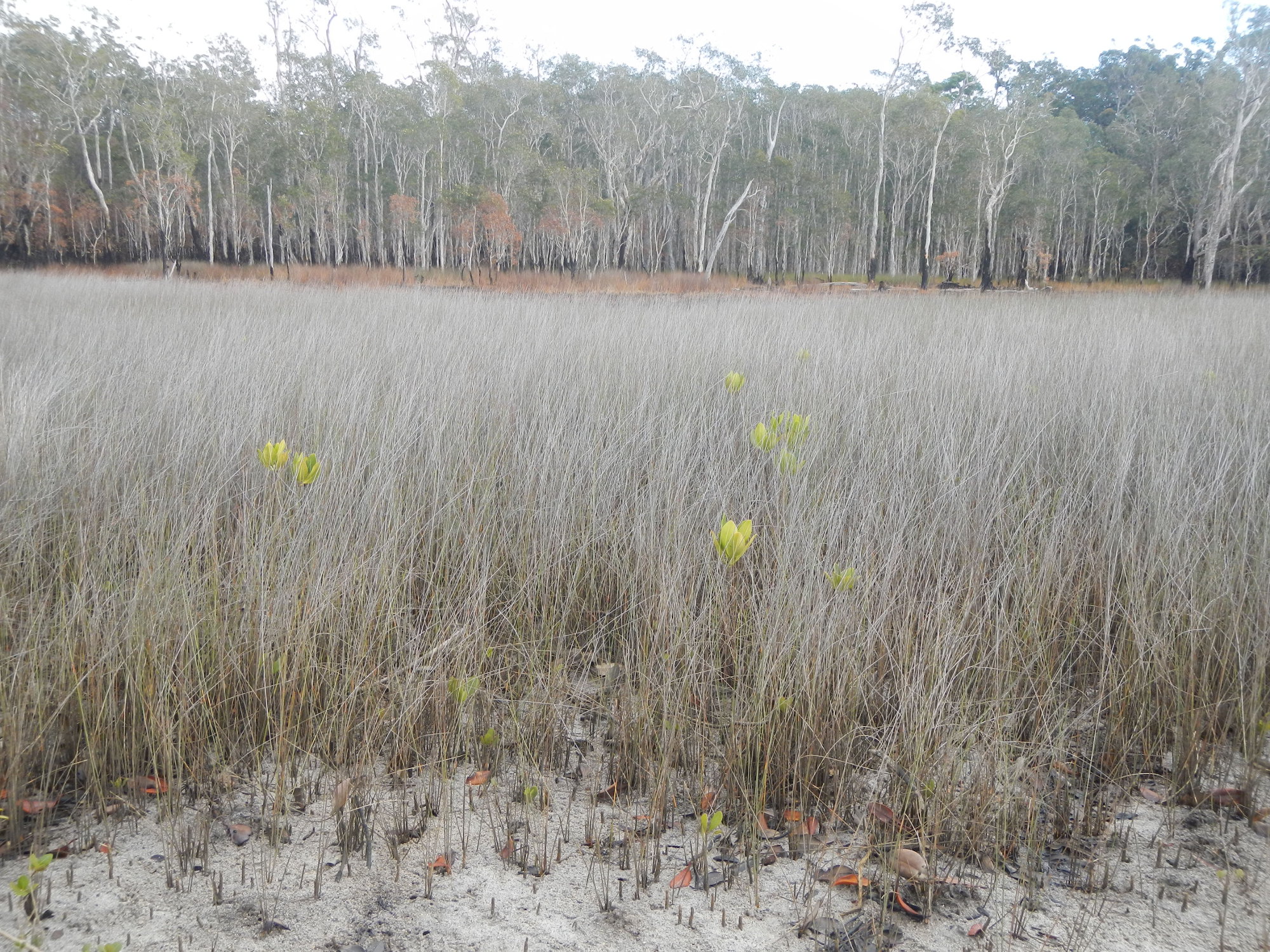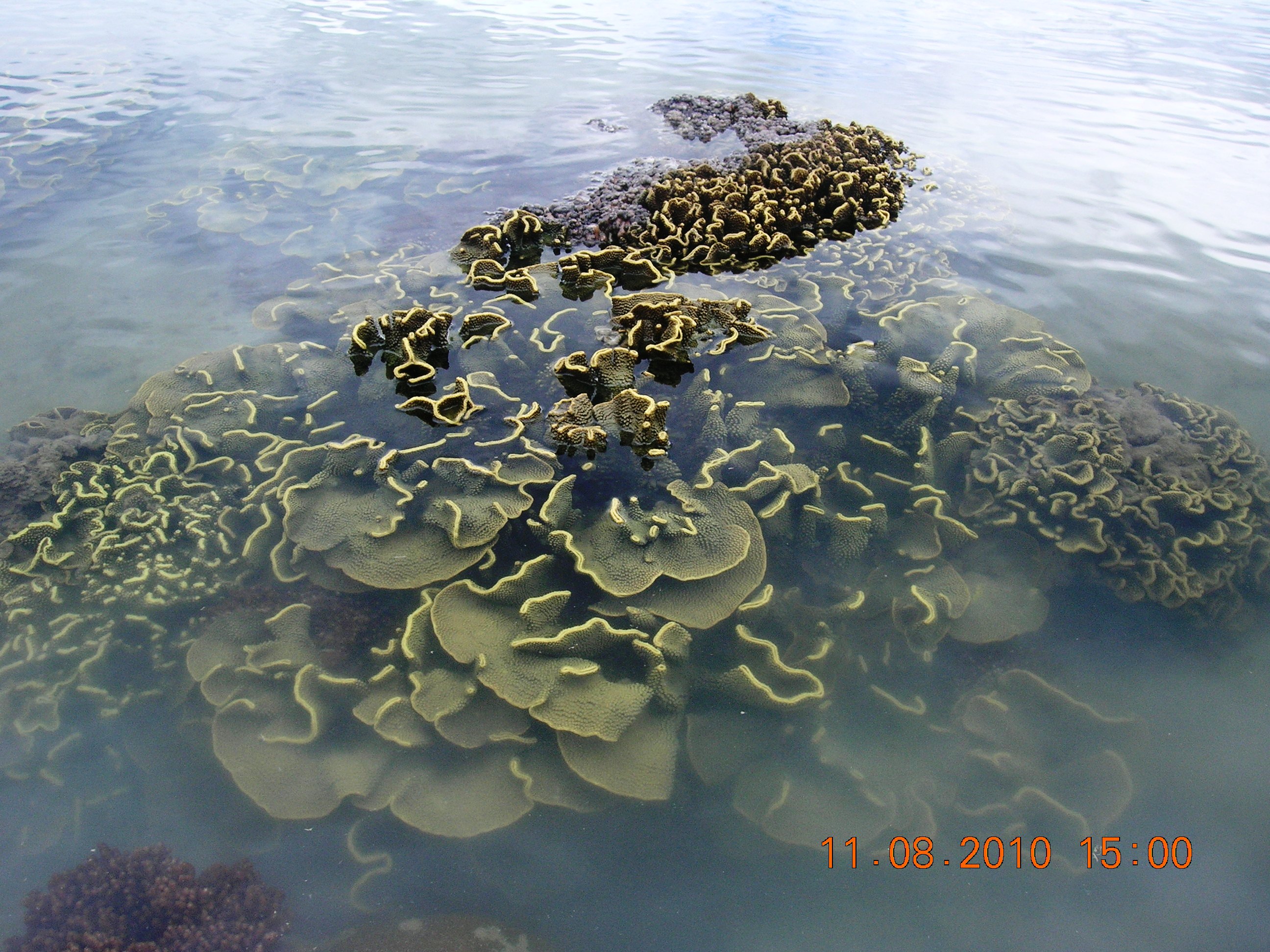|
|
Quick facts
- Structural macrobiota
- provide living space for other animals and plants, and create a diverse assemblage of life.
Fauna and flora structural biota lifeforms are drivers of both physical processes and estuarine and marine function[1]. Combinations of flora and fauna provide structural habitat –e.g. ‘fern grounds’ are a mixture of soft coral / wireweed of 0.5m height, usually on gravel substrates.
 The ability of structural macrobiota to create its own local environment and diverse assemblages makes it comparable to that of the vegetation used in terrestrial and wetland classifications. In the marine environment, this includes seagrasses, macroalgae, stromatolites, corals, sponges and other macroinvertebrates that form large enough patches to provide places for other organisms to live[2]. These structures and patches may be formed by a single primary species, such as serpulid (tubeworm), that generate reefs, or may consist of a number of primary species such as various reef building corals on a coral reef. The ability of structural macrobiota to create its own local environment and diverse assemblages makes it comparable to that of the vegetation used in terrestrial and wetland classifications. In the marine environment, this includes seagrasses, macroalgae, stromatolites, corals, sponges and other macroinvertebrates that form large enough patches to provide places for other organisms to live[2]. These structures and patches may be formed by a single primary species, such as serpulid (tubeworm), that generate reefs, or may consist of a number of primary species such as various reef building corals on a coral reef.
The intertidal flora composition categories ‘grass/herb/sedge’ and ‘trees and shrubs’ are part of the modified Specht vegetation structure[6]. Leaf form of seagrasses are correlated to ecological patterns of seagrass meadows (e.g. depth, water clarity, sediment size / compaction)[5] and to dugong food preferences[8].
Bioconstructors are ecosystem engineers that create a hard three-dimensional framework that is usually enduring. Bioconstructors create rugosity, providing 3-D living space for highly diverse biota measurable at the habitat scale[3].
Faunal structural biota often occur on consolidated substrates, but increasingly soft sediments are recognised as providing habitats for a high diversity of sessile macrofauna. These often exist in combination where the dominant taxa interchange spatially (e.g. sponge / sea fan / soft coral gardens). Certain taxa usually considered mobile also include sessile forms, e.g. sessile molluscs include mussel and oyster beds and siliquilariid (wormshell) reefs.
Queensland Intertidal and Subtidal Classification Scheme
Structural macrobiota composition falls under the 'Biota' theme of attributes for the Intertidal and Subtidal Classification Scheme. It refers to the type of (sessile) structural macrobiota (SMB).
Hard corals are important bioconstructors which are distinguishable at the regional and subregional scale, at the seascape scale by their growth forms and, at the habitat scale, the presence of reef-forming Acropora[4].
Attribute Category Table - Structural Macrobiota Composition
| Habitat |
Seascape |
Subregion |
Region |
| Unknown |
Unknown |
Unknown |
[Not applied] |
| None |
None |
None |
| Grass/herb/sedge - undifferentiated |
Grass/herb/sedge - undifferentiated |
Grass/herb/sedge |
| Grass/herb/sedge - grass or herb |
Grass/herb/sedge - grass or herb |
| Grass/herb/sedge - succulent |
Grass/herb/sedge - succulent |
| Grass/herb/sedge - sedge |
Grass/herb/sedge - sedge |
| Algae - Encrusting |
Algae - Encrusting |
Algae |
| Algae - Turf mat |
Algae - Turf mat |
| Algae - Filamentous |
Algae - Filamentous |
| Algae - Blue-green |
Algae - Blue-green |
| Algae - Erect macrophyte |
Algae - Erect macrophyte |
| Algae - Erect calcareous |
Algae - Erect calcareous |
| Algae - Undifferentiated |
Algae - Undifferentiated |
| Seagrass - Strap narrow |
Seagrass - Strap narrow |
Seagrass |
| Seagrass - Strap broad |
Seagrass - Strap broad |
| Seagrass - Ovoid |
Seagrass - Ovoid |
| Seagrass - Fern-like |
Seagrass - Fern-like |
| Seagrass - Cylindrical |
Seagrass - Cylindrical |
| Seagrass - Other or unspecified |
Seagrass - Other or unspecified |
| Mangrove - Avicennia |
Mangrove - Avicennia |
Mangroves and other salt-tolerant trees |
| Mangrove - Rhizophora |
Mangrove - Rhizophora |
| Mangrove - Ceriops |
Mangrove - Ceriops |
| Mangrove - Mixed |
Mangrove - Mixed |
| Mangrove - Undifferentiated |
Mangrove - Undifferentiated |
| Other trees - Melaleuca, Casuarina |
Other trees - Melaleuca, Casuarina |
| Other or unspecified flora |
Other or unspecified flora |
| Coral –Octocorallian (incl. gorgonians, sea pens, sea whips) |
Coral –Octocorallian (incl. gorgonians, sea pens, sea whips) |
Coral |
| Coral –undifferentiated |
Coral –undifferentiated |
| Hard coral – undifferentiated- Acropora |
Hard coral - undifferentiated |
| Hard coral – undifferentiated – non-Acropora |
| Hard coral – Branching - Acropora |
Hard coral - Branching |
| Hard coral – Branching – non-Acropora |
| Hard coral – Massive - Acropora |
Hard coral - Massive |
| Hard coral – Massive – non-Acropora |
| Hard coral –Submassive - Acropora |
Hard coral -Submassive |
| Hard coral -Submassive – non-Acropora |
| Hard coral - Plate/table - Acropora |
Hard coral - Plate/table |
| Hard coral - Plate/table – non-Acropora |
| Hard coral - Bushy - Acropora |
Hard coral - Bushy |
| Hard coral - Bushy – non-Acropora |
| Hard coral - Vase/foliose - Acropora |
Hard coral - Vase/foliose |
| Hard coral - Vase/foliose – non-Acropora |
| Hard coral - Encrusting - Acropora |
Hard coral - Encrusting |
| Hard coral - Encrusting – non-Acropora |
| Hard coral -Mixture of structures - Acropora |
Hard coral -Mixture of structures |
| Hard coral -Mixture of structures – non-Acropora |
| Sponge |
Sponge |
Other fauna |
| Mollusc - Oysters |
Mollusc - Oysters |
| Mollusc - Scallops |
Mollusc - Scallops |
| Mollusc - Other undifferentiated (e.g. bivalve, gastropod (limpet, worm shell)) |
Mollusc - Other undifferentiated (e.g. bivalve, gastropod (limpet, worm shell)) |
| Ascidian (incl. tunicates, sea squirts) |
Ascidian (incl. tunicates, sea squirts) |
| Crinoids (incl. feather stars, stalked crinoids) |
Crinoids (incl. feather stars, stalked crinoids) |
| Tubeworm (Polychaetes and phoronids) |
Tubeworm (Polychaetes and phoronids) |
| Bryozoa (incl. moss animals, lace corals, sea mats) |
Bryozoa (incl. moss animals, lace corals, sea mats) |
| Barnacles |
Barnacles |
| Other or unspecified fauna (incl. brachipods and kamptozoans) |
Other or unspecified fauna (incl. brachipods and kamptozoans) |
| Other or unspecified biota |
Other or unspecified biota |
| Unknown |
Unknown |
| None |
None |
References
- ^ Aquatic Ecosystems Task Group (AETG) (2013), Interim Australian National Aquatic Ecosystem Classification (ANAE) Estuarine - Marine Attribute Workshop Summary Report, Auricht Projects.
- ^ Cocito, S (2004), 'Bioconstruction and biodiversity: their mutual influence', Scientia Marina, vol. 68, no. S1, pp. 137-144.
- ^ Harborne, AR, Mumby, PJ & Ferrari, R (2012), 'The effectiveness of different meso-scale rugosity metrics for predicting intra-habitat variation in coral-reef fish assemblages', Environmental Biology of Fishes. [online], vol. 94, no. 2, pp. 431-442. Available at: Scopus.
- ^ Hedley, JD, Roelfsema, C, Brando, V, Giardino, C, Kutser, T, Phinn, S, Mumby, PJ, Barrilero, O, Laporte, J & Koetz, B (October 2018), 'Coral reef applications of Sentinel-2: Coverage, characteristics, bathymetry and benthic mapping with comparison to Landsat 8', Remote Sensing of Environment. [online], vol. 216, pp. 598-614. Available at: https://linkinghub.elsevier.com/retrieve/pii/S003442571830347X [Accessed 12 April 2019].
- ^ Kilminster, K, McMahon, K, Waycott, M, Kendrick, GA, Scanes, P, McKenzie, L, O'Brien, KR, Lyons, M, Ferguson, A & Maxwell, P (2005), 'Unravelling complexity in seagrass systems for management: Australia as a microcosm', Science of the Total Environment, vol. 534, pp. 97-109, Elsevier.
- ^ Neldner, VJ, Wilson, BA, Thompson, EJ & Dillewaard, HA (2012), Methodology for survey and mapping of regional ecosystems and vegetation communities in Queensland. Version 3.2 Updated August 2012., Queensland Herbarium, Queensland Department of Science, Information Technology, Innovation and the Arts, Brisbane.
- ^ Schiel, DR & Lilley, SA (2007), 'Gradients of disturbance to an algal canopy and the modification of an intertidal community', MARINE ECOLOGY-PROGRESS SERIES-, vol. 339, p. 1, INTER RESEARCH.
- ^ Sheppard, JK, Marsh, H, Jones, RE & Lawler, IR (2010), 'Dugong habitat use in relation to seagrass nutrients, tides, and diel cycles', Marine Mammal Science, vol. 26, no. 4, pp. 855-879, Wiley Online Library.
Last updated: 15 July 2019
This page should be cited as:
Department of Environment, Science and Innovation, Queensland (2019) Structural macrobiota composition, WetlandInfo website, accessed 8 May 2025. Available at: https://wetlandinfo.des.qld.gov.au/wetlands/ecology/aquatic-ecosystems-natural/estuarine-marine/itst/structural-macrobio/
|

 — Department of the Environment, Tourism, Science and Innovation
— Department of the Environment, Tourism, Science and Innovation



